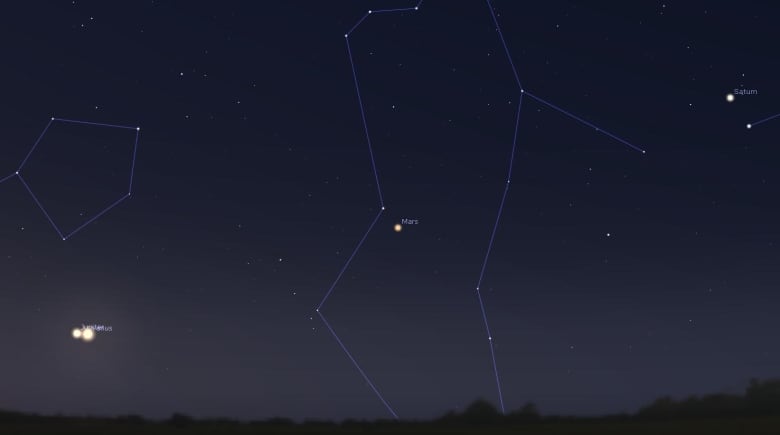
Early risers take note: Something beautiful has been happening in the east in the wee hours of the morning, and it’s about to get even better.
Over the past month, four planets — Saturn, Mars, Venus and Jupiter — have been marching upwards from the eastern horizon.
But two are ready for a super-close match-up. On Saturday and Sunday morning, Venus and Jupiter will appear almost inseparable. They will be separated by less than half the width of a full moon.
These kinds of meetings — where two celestial bodies appear extremely close together in the sky — are called conjunctions.
This is very cool! Jupiter, Venus and a crescent moon beginning their move across the sky yesterday morning. ShaughnessyB Photography with the time lapse. <a href=”https://twitter.com/hashtag/astronomy?src=hash&ref_src=twsrc%5Etfw”>#astronomy</a> <a href=”https://twitter.com/hashtag/moon?src=hash&ref_src=twsrc%5Etfw”>#moon</a> <a href=”https://twitter.com/hashtag/Jupiter?src=hash&ref_src=twsrc%5Etfw”>#Jupiter</a> <a href=”https://twitter.com/hashtag/Venus?src=hash&ref_src=twsrc%5Etfw”>#Venus</a> <a href=”https://t.co/qvaziC0M5O”>pic.twitter.com/qvaziC0M5O</a>
—@KevinJanison
Of course, the pair are actually separated by some 650 million kilometres. Their orbits just have them crossing in the same patch of sky.
How and when to find them
If you want to stumble out of bed and take a look, the best time is before sunrise, around 5 to 5:30 a.m. local time. And you’ll need to have a good view of the eastern horizon.

You’ll find two extremely bright “stars” closest to the horizon. Those are Jupiter and Venus.
The two will be less than a degree apart — 0.2 degrees, to be precise — on both April 30 and May 1.
Then, moving diagonally upwards to your right, you’ll spot a faint reddish object: Mars.
And finally moving in the same direction, you’ll see Saturn.

If you’d like to see the conjunction better, you can use a pair of binoculars. Just be sure that you put them away before the sun comes up. You don’t want to risk damaging your eyes.
After this conjunction the pair will begin to move farther apart in the sky.
The great thing about this conjunction is that it occurs between two of the brightest planets in our sky. Venus is the brightest and is often called either a “morning star” or an “evening star,” depending on where it is in the sky at the time of day. It has sometimes been mistaken for a plane or, yes, even a UFO.
Jupiter is the second-brightest planet in the sky, and is hard to miss.
These planets are so bright because they have what astronomers call a high albedo (not to be confused with libido), a measurement of the amount of light reflected off an object. Venus appears so bright for two reasons: one, because it has a high albedo due to its thick cloud cover and two, because it is so close to Earth.
In the case of Jupiter, it appears so bright because it’s just so large (it’s the biggest planet in our solar system) and has a high albedo due to its cloud cover as well.
In astronomy, magnitude is a measure of the brightness of an object; the brighter it is, the lower the number. During the conjunction of the pair, Venus will be at roughly magnitude –4.11 and Jupiter will be at –2.11.

If you want to judge how different planets vary in brightness, you can compare Jupiter and Venus to Mars and Saturn, which lie nearby. Comparatively, Mars will be at magnitude 0.93 and Saturn at 0.79. While they’re still bright, they are nowhere near as bright as Venus and Jupiter.
If your forecast calls for clouds on Saturday or Sunday, you can still head out in the days ahead to see the daily motion of the planets, as well as in the days after.












